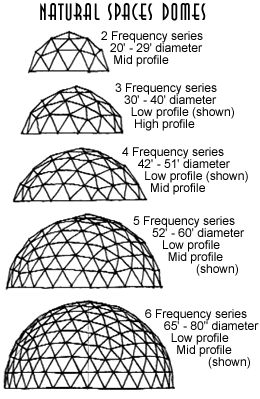
Our competition has a somewhat repetitive view of the dome. It seems to be based on their viewing the dome as an object to be manufactured. They want to keep the dome simple – for them that is.
When they build different dome sizes they simply change the strut and panel lengths proportionally. So, a 26’ diam. has 5 1/2’ maximum edge lengths and their 46’ diam has over 10’ maximum edge lengths.
They claim that by repetition of angles they can keep the cost down.
Then how is a Natural Spaces dome is cheaper?!
Why do we think their view is wrong and what do we do about it?
First of all, can you imagine lifting or dealing with a triangle having sides 10’ or greater?
On the other hand, the dome with triangles of 5 1/2’ or less on a side would be a breeze. But what about its efficiency in using materials?
Natural Spaces designs domes for people who build domes.

We feel that every part should be able to be lifted and handled reasonably by people – after all, they are going to be the person building. When the edge lengths go beyond 8’-9’, struts and panels get hard to handle.
What did we do about it? We changed the mathematics of the dome when we changed sizes. No matter if you are building a 26’ diam. dome or a 74’ diam. dome – the strut/panel sizes are about the same. This makes handling a lot more human.
It also looks better. Our larger size domes are not as clunky looking – they’re more spherical. They have a better scale and proportion to humans.
Now, the competition can argue that their large dome has fewer triangles (but they actually require more lumber to build) so what would you rather have? An aching back or a nice looking, easily erectable dome?
